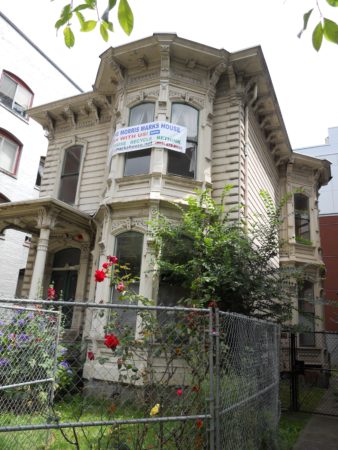
(Photo Courtesy of the City of Portland)
Restore Oregon has been advocating for the Morris Marks House for many years and sometimes the only way to save a historic building is to move it. Board member Rick Michaelson and Karen Karlsson have been working with the City of Portland and the owners for quite a while and we’re thrilled that their plan to give the house a new home appears close to fruition. The Oregonian recently published this update. From what we hear, there is still much work to be done to make relocating historic resources an easier and more efficient process.
Plan in works to preserve 136-year-old Morris Marks House
Written by Elliot Njus, The Oregonian
A long-threatened architectural gem in downtown Portland may have another chapter in it yet — on a traffic island nearly a mile away.
Preservationists are close to moving the 136-year-old Morris Marks House, a rare example of Italianate architecture currently sitting vacant at 1134 S.W. 12th Ave.
Karen Karlsson and Rick Michaelson, who have been involved in other recent efforts to save historic structures slated for demolition, are arranging to buy the house and move it to a small triangular lot near the Interstate 405 interchange at Southwest Broadway and Sixth Avenue.
The lot is owned by the city’s Parks & Recreation Bureau, and a move would require zoning and other changes by the City Council. Karlsson and Michaelson said they’re in talks to acquire the property.
Tim Crail, chief of staff for Portland Commissioner Amanda Fritz, who oversees the Parks Bureau, also confirmed a deal was in the works.
The owners of the house, meanwhile, applied in August for the demolition permit they’d need to move the house and raze the foundation. Because the house is on the city’s historic resource inventory, the permit requires a 120-day waiting period.
Steven Blindheim, whose family has owned the house and an apartment building on the same lot since the early 1990s, say there are no immediate plans for the site. But, he said, the house no longer fits in with the neighborhood.
“It’s time to pass it on to another custodian who can take better care of it than we can,” he said.
The house has been fenced off and boarded up in recent years to keep out intruders.
Blindheim “has done a fine job of keeping it from deteriorating,” Karlsson said. “The house is still really incredible.”
Karlsson and Michaelson are buying the house for $1, and will pay half the cost of demolishing its foundation. Once moved to the city lot, the building will be repurposed as apartments or office space.
Moving the housewould mean hauling it nearly a mile over the Portland State Univeristy campus. The university would need to approve the route, which is complicated by underground tunnels that could be compromised by the weight of the house. The move would likely take two days.
The two also led an effort to buy Northwest Portland’s Goldsmith House, built in 1902, after it was purchased by a developer who planned to replace it with seven townhouses. The house has since been resold to a couple who’s living in the house while they slowly restore it.
And they were part of a partnership that bought century-old Bull Run powerhouse, a decommissioned hydroelectric site north of Sandy.
While eleventh-hour efforts to save historic homes have become the norm amid Portland’s development frenzy, the Morris Marks House has been on preservationists’ minds for years. Plans to move the house to the same traffic island in 2010 fizzled out.
“It’s a survivor from a time when there aren’t very many left,” said Val Ballestrom, education manager at the Bosco-Milligan Foundation, a historic preservation nonprofit. “It retains a lot of those original Italianate architectural elements. There’s not a lot of those left in Portland.”
The house was designed by Warren Williams, a prolific Portland architect whose work includes The Old Church and several cast-iron commercial buildings that still stand in Old Town. The first owner was Morris Marks, a Polish shoe merchant.
Marks went on to own a second, larger home built in a similar style. It was built at what’s now Southwest 11th Avenue and Clay Street, but was moved in the early 1900s to its present location at 1501 S.W. Harrison St. That house was listed on the National Register of Historic Places in 1975.

